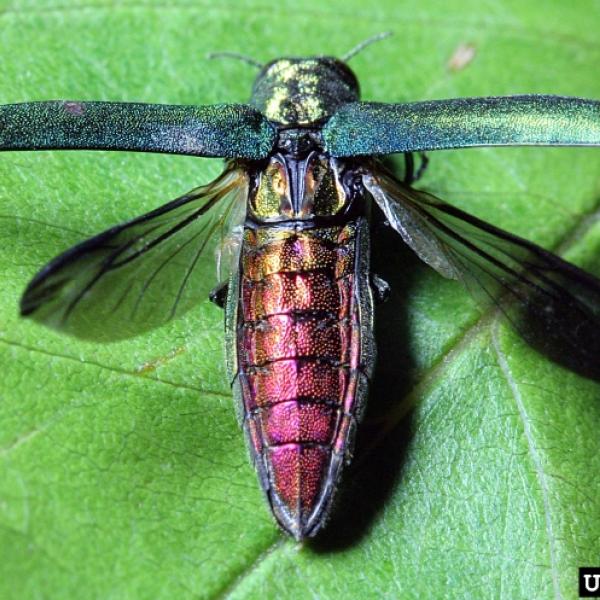
News Source
On July 31st, the USDA Animal and Plant Health Inspection Service alerted state officials that an emerald ash borer (EAB) beetle was captured on a purple detection trap in the town of Stamford, VT. This location is within five miles of another recent EAB detection in the town of North Adams, MA. This invasive insect was first discovered in Vermont in February, and has also been confirmed in Orange, Washington, and Caledonia counties.
State and federal agencies are planning a delineation survey based on tree symptoms to determine the extent of the newly detected EAB infestation. Landowners and other residents of Stamford and surrounding towns are urged to look for signs and symptoms of the insect and report suspicious findings on vtinvasives.org (link is external).
Detailed information about the pest and what to look for may be found at the same website. As part of an ongoing effort to detect EAB, the USDA has already deployed purple detection traps at 609 locations throughout Vermont. The traps will be removed and examined in September, at the end of EAB’s flight season.
Although it may be hard to see, EAB is likely to be present in other locations within ten miles of known infestations. In southwestern Vermont, this includes all of Stamford and Readsboro, as well as parts of Pownal, Woodford, Bennington, Searsburg, Whitingham, and Wilmington.
Moving any infested material, especially ash firewood, logs, and pruning debris, can quickly expand the infestation, so it is critical Vermonters follow the ‘slow-the-spread’ recommendations, available at vtinvasives.org/land/emerald-ash-borer (link is external).
One important recommendation is to only buy local firewood.
EAB larvae kill ash trees by tunneling under the bark and feeding on the part of the tree that moves water and sugars up and down the trunk. It was first discovered in North America in the Detroit area in 2002, and over the past sixteen years, it has decimated ash populations. EAB was recently detected in Maine and Rhode Island and is known to occur in 35 states and four Canadian provinces. Ash trees comprise approximately 5% of Vermont forests and are also a very common and important urban tree. EAB threatens white ash, green ash and black ash in Vermont and could have significant ecological, cultural, and economic impacts.
A public information meeting is being planned in the Bennington County area for early September and details will be announced shortly.